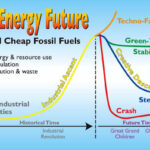Possible Ways off the Mountain

“Anyone who believes that exponential growth can go on forever in a finite world is either a madman or an economist.”
–Kenneth E. Boulding
I usually begin the economics portion of my talks with an overview: that we’re coping with a triple crisis. I follow that with a detailed view of each of the three elements:
- Climate change: what the Union of Concerned Scientists forecasts for climate change here in my state of California;
- Peak oil: what ASPO, the U.S. Department of Energy, and the International Energy Agency anticipate as the future of petroleum, together with possible repercussions as outlined by Richard Heinberg, James Howard Kunsler and company. Peak oil is really a subset of “peak everything.”
- Economic contraction: long-term, ongoing, relentless …more on this in a moment.
Over the course of industrialized civilization we have experienced an enormous assent of consumption of raw materials and consumption of energy. In his Energy Descent diagram, David Holmgren depicts this as the climb up the mountain. Right now, at the peak of the mountain, what are our options? What are the possible ways forward?
The first option, the orange line, “Techno-fantasy,” is the business-as-usual, eternal growth scenario. It says We’ll just keep going the way we are now, with more of the same. Keep on shopping! Don’t worry that we don’t have the oil to keep going like this, we’ll just send an army over and conquer the country that has it ... We’ve heard this one before, and you’ll note the word “fantasy” in the name.
The second scenario, the “Green Tech Stability” model, says Okay, we know that eternal growth isn’t possible, so we’ll ditch the growth idea. We’ll just continue along at a reasonable level, kind of steady, right where we are now. So we’re running out of oil: we’ll use wind and solar and biofuels and all that renewable stuff to replace it.
But there are some serious problems with this Green Tech proposal. One is the idea of energy density: oil gives us tremendous power, and no combination of renewables can possibly replace what it does for us. The second is timing: those renewables aren’t in place now, in anywhere near sufficient quantities, to avoid the pain of energy shortages. We will still have to powerdown.
The third problem is that our entire economy is built upon the presumption of everlasting growth. Everything from our stock market to our accounting systems is founded upon the premise that growth is good and lack of growth is failure. Thus even the adjustment from that steeply ascending line to the flat line is a very significant one. We will feel the ouch. The fourth is the “peak everything” issue. There is a serious problem with the level at which we declare that stability (but we’ll get into that in Part II). For these four reasons, we should be calling this a Green Tech fantasy scenario.
The third scenario, the red line, is the Crash scenario, the Mad Max scenario, the collapse of civilization as we know it. This is what happens if we keep on going with the Techno-fantasy and ignore the problem a little longer. Now, I have two children growing up to find their way in this world. I say, there’s got to be a better alternative than this.
Holmgren presents another scenario, the Energy Descent scenario. This scenario says we can take the boundless creativity that got us up the mountain and apply it toward actively designing a careful way down. This is the approach embraced by the international Transition movement.
It is very important to understand that inherent in the Energy Descent scenario is the downhill slope – the understanding that there must be a descent. There must be a powerdown. There must be a significant decrease in consumption overall. And as you will see in the following discussion, that means there will inevitably be a severe contraction in our economic systems.


